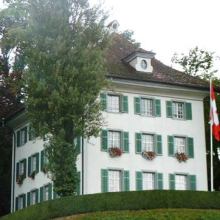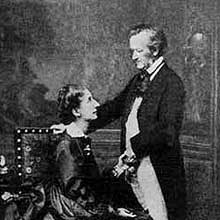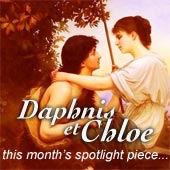The Siegfried Idyll
A Delicate Symphonic Poem
The Siegfried Idyll, Wagner's delicate, peaceful birthday gift to his wife, is one of the composer's rare non-operatic pieces.
It definitely has a characteristic Wagner sound, but in a more tender form. He did eventually use some ideas and themes from the chamber piece in the opera Siegfried.
Wagner wrote the piece as a birthday present for his wife Cosima (Liszt's daughter). The pieces tender and intimate sound is meant to celebrate Wagner's love for her.
Idyll History

The first performance was on the staircase in the Wagner's villa, on the morning of Christmas Day 1870 (Cosima's birthday was Christmas Eve).
Cosima was sleeping, and she woke up to the beautiful opening melody, with Wagner conducting a small group of musicians he had invited from Zuerich. What a lovely birthday present!
The original title of the piece was "Tribschen-Idyll, with Fidi-Birdsong and Orange Sunrise". It's obviously a very personal piece for Wagner judging by the name!
Tribschen is the name of the villa in Lucerne, Switzerland, where Wagner was living in exile with his family.
Fidi is the pet name for Siegfried, Wagner's small son.
I think it is called the "Tribschen-Idyll" because Wagner's villa was in a very beautiful area. Wagner wrote to King Ludwig II of Bavaria: "Wherever I turn outside my house I am in the midst of a magic world: I know of no more beautiful place on earth, none homelier than this."
Wagner didn't publish the work until 8 years later, when he was lacking money. It was a slight shame since the piece was meant to be intimate and personal (I'm not complaining though).
He beefed up the orchestration by adding more players and instruments, changed the title to Siegfried Idyll, and sold the score to a publishing house. I'm glad he did - from that time onwards this beautiful piece was available for the public to hear.
Most of Wagner's output was operatic - click to explore the composer's operas!
The Music

The Siegfried Idyll is roughly 20 minutes long.
Wagner wrote it for a small orchestra of 13 different instruments, probably the maximum amount of musicians he could fit on the landing of his staircase.
They are: two violins, one viola, one cello, one double bass, one flute, one oboe, two clarinets, two horns, one trumpet, and one bassoon.
Despite his limited instrumental forces, Wagner still manages to create utterly beautiful shades of tone by using clever combinations. The single instruments give the piece bold, simple colors, capturing the feelings of affection which inspired it.
The piece has a symphonic sound even though it has nowhere near the number of instruments a proper symphony orchestra does.
Wagner used some of the melodies from the Idyll for the end of his opera Siegfried. He was struggling a bit with writing the third act, and the material fitted well.
Here are some themes from the Idyll which made it into the opera, and the corresponding bits in the opera:
- Melody 1:
- Melody 2:
- Melody 3:
- Melody 4:
Recommended Recordings
Since the piece is exquisitely delicate and soft, I think that a conductor needs to perform it slowly and carefully. Some conductors, however, rush through the piece (yes, you, Neeme Jarvi!), and so lose the idyll's poignant charm.
One recording I like is conducted by Glenn Gould. His delicate interpretation evokes all the tender feelings Wagner injected into the music. Gould was also very close to death when he recorded the piece (1982), so the recording has an air of wisdom and poignancy.
Gould also transcribed and performed the entire Siegfried Idyll for solo piano. His conducting performance and his piano performance are on the same CD, which I recommend:
If you're interested in more of the history of the piece, you can look at the website of the Tribschen Villa, which is now a Wagner museum.
Return from Siegfried Idyll to Richard Wagner Biography
Return to Favorite Classical Composers homepage
If you like my site, please click "Like"... thanks!



